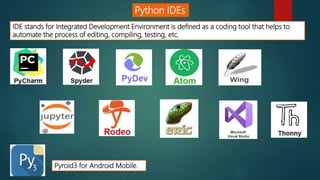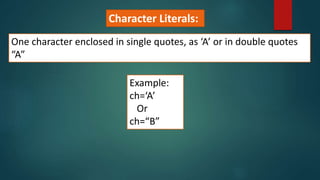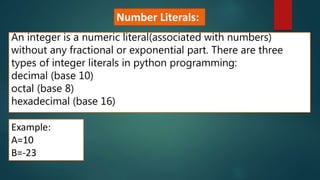Python Introduction
- 1. PYTHON GETTING STARTED WITH PYTHON CLASS: XI COMPUTER SCIENCE(083)
- 2. What is Python? Python is an object-oriented programming language developed by Guido Van Rossum in 1991.Python is a general purpose, dynamic, high-level language. It supports Object Oriented programming approach to develop applications. It is simple and easy to learn. Its an open source language. Python programming is widely used in Artificial Intelligence, Natural Language Generation and other advanced fields of Computer Science. Python files have extension filename.py So if you want to save the file of python then write: myfile.py
- 3. What is High-level language? A high-level language is a programming language which is designed to make computer programming easy to understand. All these HLL source code converted into machine understandable code with the help of there compilers that convert it. It is a programming language such as C, FORTRAN, or Pascal that enables a programmer to write programs that are more or less independent of a particular type of computer. Such languages are considered high-level because they are closer to human languages and further from machine languages. Java , C++ , C# , Visual Basic , JavaScript, Python
- 4. Object Oriented programming OOP stands for Object-Oriented Programming. Object-oriented programming is about creating objects that contain both data and functions. It is based on objects, instead of just functions and procedures. An "object" is a instance of a class. Each object has a structure similar to other objects in the class, but can be assigned individual characteristics. Class Object A class is a template or a blu-print representing a group of objects that share common properties and relationships. An object is a instance of a class. An object is nothing but a self-contained component which consists of methods/behaviors and properties/states.
- 5. Let us understand Class: A class is a template or a blu-print representing a group of objects that share common properties and relationships. Class is divided into two part: State/Attributes Behaviors The state or attributes are the built in characteristics or properties of an object The behavior or operations of an object are its predefined functions
- 6. Let us understand with the help of example: Television Class State/Attributes size, colour, model, sound,channels etc. ------------------------ Behaviors PowerOn, PowerOff, Increase(+)/Decrease(-) volume etc. Objects Samsung Sony LG
- 7. Let us understand with the help of example: Class: DOG State/Attributes Breed, size, colour,age ------------------------ Behaviors Eat,Run,Sleep….. State/Attributes Breed=“Germanshepard” Size= Large Colour= Dark Brown Age= 5 years State/Attributes Breed=“Pug” Size= small Colour= light brown Age= 1 years Object
- 8. Python is known for its general-purpose nature that makes it applicable in almost every domain of software development. It provides libraries to handle Python Applications Web Applications Desktop GUI Applications Console-based Application Software Development Scientific and Numeric Business Applications Audio or Video-based ApplicationsImage Processing Application
- 9. Python Features Easy to Learn and Use Expressive Language Interpreted Language Cross-platform Language Python is easy to learn as compared to other programming languages. Python can perform complex tasks using a few lines of code. it means the Python program is executed one line at a time. Python can run equally on different platforms such as Windows, Linux, UNIX, and Macintosh, etc. So, we can say that Python is a portable language.
- 10. Free and Open Source Object-Oriented Language Large Standard Library GUI Programming Support Embeddable Python is freely available for everyone. Python supports object-oriented language and concepts of classes and objects come into existence. It provides a vast range of libraries for the various fields such as machine learning, web developer, and also for the scripting. The code of the other programming language can use in the Python source code. We can use Python source code in another programming language as well. Graphical User Interface is used for the developing Desktop application. PyQT5, Tkinter, Kivy are the libraries which are used for developing the web application.
- 11. How to Install Python Visit the link https://www.python.org/downloads/ to download the latest release of Python.
- 12. Python IDEs IDE stands for Integrated Development Environment is defined as a coding tool that helps to automate the process of editing, compiling, testing, etc. Pyroid3 for Android Mobile.
- 13. Python Character Set: Character set is an asset of valid characters that a language can recognize. A character can represents any letter, digit, or any other sign. Following are some of the character set. LETTERS A to Z and a to z DIGITS 0 – 9 SPECIAL SYMBOLS + -* [] {} = != < > . ‘ ‘ ; : & # WHITE SPACE Blank space , horizontal tab
- 14. TOKENS: In a passage of text, individual words and punctuation marks or smallest lexical unit in a program is known as token. keywords Identifier Literals PunctuatorsOperators
- 15. keywords Keywords are the reserved words in Python. keywords are case sensitive. There are 33 keywords. Each keyword has a special meaning and a specific operation, we cant modify or change the meaning of these keywords. True False None and as asset def class continue break else finally elif del except global for if from import raise try or return pass nonlocal in not is lambda
- 16. Identifier An identifier is a name given to entities like variables, functions, classes etc. It helps to differentiate one entity from another. Rules for writing identifiers identifiers can be a combination of letters in lowercase (a to z) or uppercase (A to Z) or digits (0 to 9) or an underscore (_) An identifier cannot start with a digit.Example: 1var ab+1 ad 123 ch$ Ab#12 Invalid
- 17. So if we need to write a valid identifiers are: ABC1 abc12 ad12cd ab_123 _abc Invalid identifiers are: 12abc abc 12 ab@12 ab$$1 Ab*%1 It means if we use any special symbols with letters then its an invalid identifiers or spaces between the characters Ab+1
- 18. Literals Literals referred as Constants also, python Literals can be defined as data that is given in a variable. These are data items that never change their value during a program run. Kinds of Literals are: Character Literals: String Literals: Integer Literals: Floating Literals: Bool Literals:
- 19. One character enclosed in single quotes, as ‘A’ or in double quotes “A” Example: ch=‘A’ Or ch=“B” Character Literals:
- 20. String literals can be formed by enclosing a text in the quotes. We can use both single(‘) as well as double quotes(“) to create a string. Example: name=“Rohan” Or Name=‘Rohan’ String Literals:
- 21. An integer is a numeric literal(associated with numbers) without any fractional or exponential part. There are three types of integer literals in python programming: decimal (base 10) octal (base 8) hexadecimal (base 16) Example: A=10 B=-23 Number Literals:
- 22. Floating-point Literals A floating-point literal is a numeric literal that has either a fractional form or an exponent form. For example: Example: A=2.445 B=0.5567 C=-2.345
- 23. A Boolean literal can have any of the two values: True or False. Example: result=(10==20) The result will store result in the form of True or False Bool Literals:
- 24. Punctuators These are also known as separators. Brackets: [ ] Parentheses ( ) Braces { } Comma , Semi colon ; colon : and many signs…… Operators Operators are special symbols which represent computation. They are applied on operands which can be values or variable. Example: +, -, / , * ……..
- 25. How write Comments in python? Comments are very important while writing a program. These are ignored by the python interpreter and have no effect on the actual output code. Comments make the code more readable and understandable for human being. Comment describe what is going on inside a program before looking at the source code. In Python, we use the hash (#) symbol to start writing a comment.
- 26. #This is a comment Single line Comments : Put the # hash sign and then the statement #This is a comment1 #This is a comment2 #This is a comment3 Multi line Comments : Put the # hash sign and then the statement , then write another statement with # hash sign
- 27. How to display statements using print() function. So if we want to display any statement in python we have to use print() function Example: if we want to print statement “Hello Python, Welcome to programming” print(“Hello Python, Welcome to programming”)
- 28. So if we want to display output as shown below: ++++++ ###### ====== print(“++++++”) print(“######”) print(“======”)
- 29. So if we want to display output as shown below: *********** * * * * *********** Line 1 Line 2 Line 3 Line 4 “***********”print( ) print( )“* *” print( )“* *” print( )“***********” In Line 2 and Line 3 After first * there is a space for that we need to press spacebar
- 30. Using print display the following outputs: *********** * * ***** * * * * * * * * * * * * * * * * * * * * * print(“***************”) print(“*”) print(“*”) print(“*”) print(“**********”) print(“*”) print(“*”) print(“*”)
- 31. Using print display the following outputs: A @ @ @ @@@@@ @ @ @ @ print(“ @”) These blank box are spaces press spacebar print(“ @ @”) print(“ @@@@@”) print(“ @ @”) print(“@ @”)
- 32. Using print display the following outputs: * * * * * * * * * * * * * * * * * * * * * * * * * * * * * * *
- 33. Python Escape Characters To insert characters that are illegal in a string, use an escape character. An escape character is a backslash followed by the character you want to insert. n New Line It move the cursor to next line t Tab It is use for horizontal tab b Backspace it move cursor one step back and overwrite the character with next character over it.
- 34. We are the so-called "Vikings" from the north. If we want to print the output as shown below: print ("We are the so-called "Vikings" from the north.") If we write the print line as shown below it will display error: To solve this error : Use the escape character " print ("We are the so-called "Vikings" from the north.")
- 35. If we want to print the output as shown below using single print: We WELCOME You to Python program We WELCOME You to Python program print ("We WELCOMEn Yout ton Pythont program") Next Line use n Next Line use n Use tab t Use tab t
- 36. If we want to print the output using backslash b : Example: remove double letters from the word given below: WWELCCOMME Output using b : WELCOME print ("WbWELCbCOMbME") If we use b between W and W in an above statement, it will overwrite W with next W, same with C and M
- 37. More use of print(): Syntax: print(values or statements, sep=‘ ‘, end=‘n’) sep:- string or symbol inserted between values, by default , a space end:- string appended after the last value, default, a new line Example: print(10,20,30) ----Output---- 10 20 30
- 38. If we want to print the output 10 20 30 with comma(,) sign use sep, it means separator Example: print(10,20,30,sep=“,”) ----Output---- 10,20,30 If we want to print the output 10 20 30 with (* or &) sign use sep, it means seperator Example: print(10,20,30,sep=“*”) ----Output---- 10*20*30 Example: print(10,20,30,sep=“&”) ----Output---- 10&20&30
- 39. If we want to print the output 10 20 30 with space using t Example: print(10,20,30,sep=“t”) ----Output---- 10 20 30 If we write print(10,20,30) in a separate line using n.How you print. print(10,20,30,sep=“n”) ----Output----10 20 30
- 40. If we want to print the output like this given below: APPLE,GRAPES,MANGO !!!!!!!! Hint : we have to use sep for comma(,) and (!) inside end print(‘APPLE’,’GRAPES’,’MANGO’, sep=“,”,end=‘!!WOWn’) ----Output---- APPLE,GRAPES,MANGO !!WOW
- 41. Variable: Variable is a name that is used to refer to memory location. Python variable is also known as an identifier and used to hold value. A Python variable is a reserved memory location to store values. In other words, a variable in a python program gives data to the computer for processing.
- 42. How to Declare , Initialize and use a Variable Example: If we want to store a value 20 in a variable A. Means we need to declare a variable A and store value 20 as integer / number(0-9) A=20 Example: If we want to store a value ‘A’ character in a variable ch. Means we need to declare a variable ch and store character ‘A’ in it. ch=‘A’ Character , words or paragraph use single quotes (‘) or double quotes(“)
- 43. How to Declare , Initialize and use a Variable Example: If we want to store a value ‘computer’ word or string in a variable nm. Means we need to declare a variable nm and store word ‘computer’ in it. nm=‘computer’ Character , words or paragraph use single quotes (‘) or double quotes(“) nm=“computer” OR













![Python Character Set:
Character set is an asset of valid characters that a language can
recognize. A character can represents any letter, digit, or any
other sign.
Following are some of the character set.
LETTERS A to Z and a to z
DIGITS 0 – 9
SPECIAL SYMBOLS + -* [] {} = != < > . ‘ ‘ ; : & #
WHITE SPACE Blank space , horizontal tab](https://image.slidesharecdn.com/pythonintro-200920085010/85/Python-Introduction-13-320.jpg)










![Punctuators
These are also known as separators.
Brackets: [ ] Parentheses ( ) Braces { }
Comma , Semi colon ; colon :
and many signs……
Operators
Operators are special symbols which represent computation.
They are applied on operands which can be values or variable.
Example: +, -, / , * ……..](https://image.slidesharecdn.com/pythonintro-200920085010/85/Python-Introduction-24-320.jpg)


















